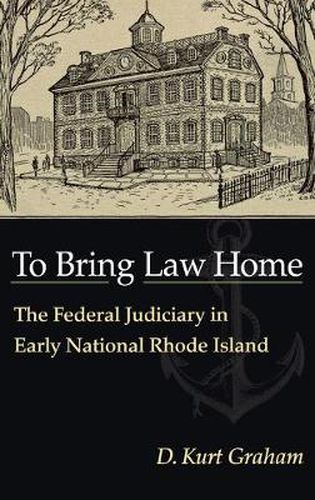Readings Newsletter
Become a Readings Member to make your shopping experience even easier.
Sign in or sign up for free!
You’re not far away from qualifying for FREE standard shipping within Australia
You’ve qualified for FREE standard shipping within Australia
The cart is loading…






In this original study, Kurt Graham sheds light on both an understudied institution and an underappreciated period in our nation’s judicial history with an examination of the federal judiciary-the district and circuit courts-during the early national period. Using Rhode Island as a case study, Graham argues that the federal judicial system exerted a significant nationalizing influence on the citizens and states of the new American nation.
Graham illustrates how the federal judiciary brought a federal presence and national authority to bear in Rhode Island, a state that had resisted federal union longer than any other. Rhode Island represents an ideal example: in part because of its initial resistance to federal union-a condition that made the national presence more conspicuous-and in part because of its heavy involvement in commerce. The national government’s income came from customs duties, which gave Rhode Island and the federal courts there a significance they otherwise might not have had. The federal courts in Rhode Island highlight both the localized nature of national authority and the relative strength of the national government from its inception.
The district and circuit courts have lived in the shadow of the U.S. Supreme Court and have been considered inferior courts in every sense. Beginning with Charles Warren’s groundbreaking 1922 work, The Supreme Court in United States History, legal historians have focused on the significance of the Supreme Court, its decisions, and its justices. Because of this focus, the role of the lower courts-which is where most of the federal judicial activity took place in the early republic-has gone virtually unexplored. Graham contends that the lower federal courts were instrumental in establishing and maintaining national supremacy and in steadily enhancing the power of the national government. Legal historians and scholars of the early republic will appreciate this insightful book that opens a window onto an often overlooked aspect of U.S. history.
$9.00 standard shipping within Australia
FREE standard shipping within Australia for orders over $100.00
Express & International shipping calculated at checkout
In this original study, Kurt Graham sheds light on both an understudied institution and an underappreciated period in our nation’s judicial history with an examination of the federal judiciary-the district and circuit courts-during the early national period. Using Rhode Island as a case study, Graham argues that the federal judicial system exerted a significant nationalizing influence on the citizens and states of the new American nation.
Graham illustrates how the federal judiciary brought a federal presence and national authority to bear in Rhode Island, a state that had resisted federal union longer than any other. Rhode Island represents an ideal example: in part because of its initial resistance to federal union-a condition that made the national presence more conspicuous-and in part because of its heavy involvement in commerce. The national government’s income came from customs duties, which gave Rhode Island and the federal courts there a significance they otherwise might not have had. The federal courts in Rhode Island highlight both the localized nature of national authority and the relative strength of the national government from its inception.
The district and circuit courts have lived in the shadow of the U.S. Supreme Court and have been considered inferior courts in every sense. Beginning with Charles Warren’s groundbreaking 1922 work, The Supreme Court in United States History, legal historians have focused on the significance of the Supreme Court, its decisions, and its justices. Because of this focus, the role of the lower courts-which is where most of the federal judicial activity took place in the early republic-has gone virtually unexplored. Graham contends that the lower federal courts were instrumental in establishing and maintaining national supremacy and in steadily enhancing the power of the national government. Legal historians and scholars of the early republic will appreciate this insightful book that opens a window onto an often overlooked aspect of U.S. history.